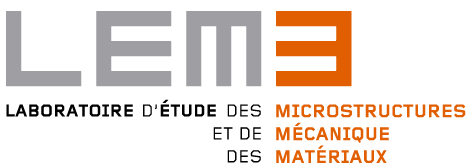- 1st floor meeting room, LEM3 – site Metz Technopôle, 7 rue Félix Savart, 57070 Metz
Under the aegis of the Medicis programme



Abstract
Surface plays a key role in the fatigue strength of metallic alloys, especially in high cycle fatigue regime (1E6 – 1E7 cycles) because material defects are present at the surface or in the subsurface of components. But, internal fatigue crack initiation and growth are very often observed in the gigacycle fatigue regime (1E8 cycles and beyond), i.e. for very low stress levels. The physical reasons explaining why crack initiation shifts from the surface to the bulk when the cyclic load level is decreased are still not very clear. Based on in-situ ultrasonic fatigue tests, this talk shows recent advances in understanding crack initiation and early crack growth in a cast Al alloy and a Ti-Al alloy. The experiments were carried out in air under axial fully reversed loading with an home made ultrasonic fatigue testing device. For the cast Al-alloy (with a relatively large grain size), it is shown that crack initiation does not represent the major part of the fatigue life in the gigacycle regime, but the crack strongly interacts with the microstructure. Internal crack propagation kinetics are compared to crack propagation data at 20 kHz in air and at 20 Hz in vacuum (from
literature). For the Ti-Al alloy, two series of smooth specimens were tested. One batch with an artificial internal sharp notch with a chimney which brings air from the surface to the internal notch. And the specimens of the other batch are not linked to the surface. By connecting the artificial internal notch with the surface, these experiments report the first direct observations that internal cracks in contact with air propagate like surface cracks in air for the studied alloy. Furthermore, it is shown that there is a huge difference in lifespan – for the same stress amplitudes – between cracks in contact with air and internal cracks (i.e. under vacuum environment). The physical nature of the concept of fatigue limit is discussed based on these direct observations.
To attend on teams
It is also possible to attend the seminar on Microsoft Teams.





